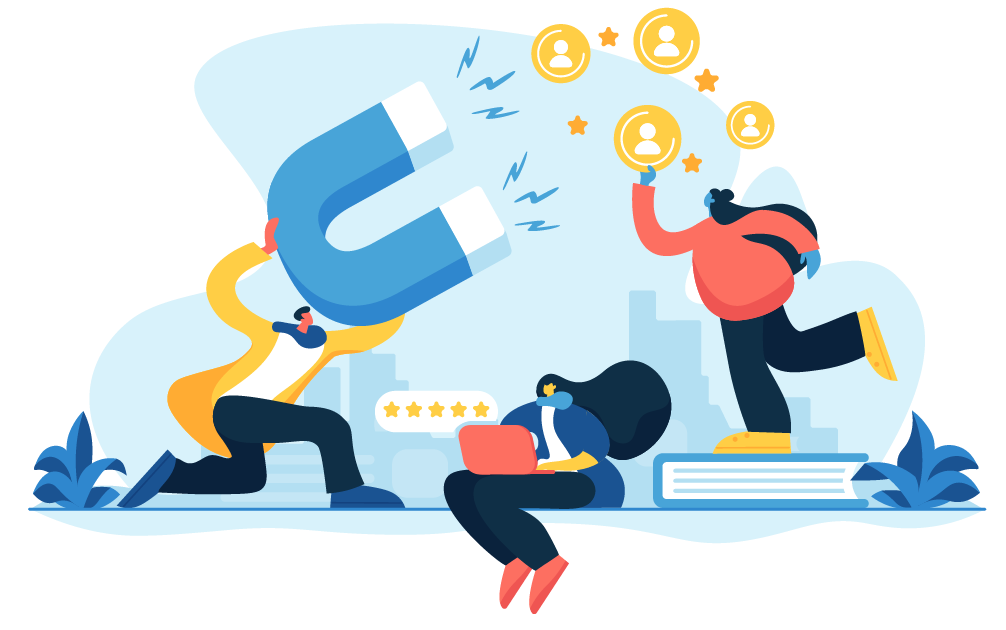
Customer satisfaction and retention go together. After all, happy customers stick around. Positive interactions develop loyalty—and that allegiance equals dollar signs.
A study published in Harvard Business Review found that positive experiences generate 140% more customer spending with a company over time. But the financial boon for improving customer retention does not stop there. Conservative estimates show acquiring a new customer can cost five times more than retaining an existing one. Sales success rates among existing customers average 60-70% versus new customers topping out at 20%.
Despite the numbers, companies often focus their efforts on the wrong consumer. A survey of marketers found that more than 60% cite their primary role as targeting new leads. No amount of spending or resources can grow a business if customer retention is a problem. First-time clients simply do not deliver the same value as existing customers. That is why a focus on customer satisfaction is one of the best strategies a company can deploy.
What Is Customer Satisfaction?
Customer satisfaction is a metric for how well a company, product, or service fulfills the needs and expectations of a consumer. The metric refers to how a customer feels about the brand based on interactions throughout the customer journey. As a simpler way of looking at it, customer satisfaction measures how delighted customers feel when they do business with the company.
Many factors influence customer satisfaction, including:
- Perceived product quality and value
- Convenience of accessing information, making a contact, or doing business
- Customer expectations for the company, product, or service
- Communication
- Handling of complaints or customer support inquiries
Most companies have multiple different customer groups including buyers, suppliers, and employees. Understanding the needs of every type of customer and what makes them happy is paramount to improving satisfaction and customer value.
What Is Customer Retention?
Customer retention encompasses many different activities. At a basic level, customer retention looks at how long customers stay customers.
Do they purchase a product just once?
Do they subscribe for a year and not renew?
Do they become brand loyalists, making repeat purchases across their lifetime?
The answers to these questions show the larger role of customer retention, which is how well a company can turn customers into repeat buyers and prevent them from going to a competitor. Customer retention strategies represent the processes, activities, and tools businesses use to build customer loyalty and improve their lifetime value to the company.
The Relationship Between Customer Satisfaction and Retention
Think of customer satisfaction as a predictor of customer retention and loyalty. The better customers feel about an interaction with a brand, the more likely they are to repeat the process. Customer satisfaction focuses on actions that create positive attitudes and feelings today to drive future behavior among the customer base.
Improving customer satisfaction and retention benefits a company’s bottom line in multiple ways.
- The ability to retain customers reduces marketing and sales spend. Subsequent sales conversions require less advertising, time, and effort if the individual consumer or B2B buyer was happy with the previous interaction.
- Satisfied customers typically buy more, and 86% indicate they are willing to pay a higher price for that positive experience with the brand. According to Qualtrics, businesses that focus on customer experience enjoy consumers seven times more likely to make a purchase and eight times more likely to try the company’s other products and services.
- Satisfied customers become the best salespeople. Research shows 90% of consumers tell their networks about service experiences. They refer friends and family, post online reviews, or share stories on social media.
The Nextdoor app offers a notable example of the power of customer satisfaction on social selling. The neighborhood feed is full of people seeking recommendations for local veterinarians, tradespeople, and restaurants. Users respond with suggestions based on their own experiences with a business. These brands benefit from free marketing across a platform with 63 million users.
- Less customer churn staves off the competition. Digital storefronts and e-commerce make the barrier to entry for a business lower than ever. Satisfied customers shop around less and remain loyal to existing brands.
- Customer satisfaction and loyalty, established through multiple positive interactions, build a reservoir of goodwill when something inevitably goes wrong. Loyal customers are significantly more likely to forgive an organization following a poor experience without taking their business to a competitor.
Five Tips to Improve Customer Satisfaction and Retention
No company underperforming in customer satisfaction and retention can turn things around overnight. However, five key areas can get things moving in the right direction. Improving customer experience requires a long-term strategy and a consistent investment every day. The extra effort to create happy, loyal customers who want to come back will pay off throughout the organization.
Always Provide Great Customer Service
Okay, this may seem obvious. It is not as if any business wants to provide bad customer service. Yet so many companies do.
Many organizations build their customer experience journey based on what they want the customer to do rather than the paths consumers actually take. Think about companies pushing for paperless client billing. They save on paper, postage, and staffing. That act forces the consumer to set up direct payment through their bank, access a bill through a website, go to a select pay location, or use automated phone prompts. The company saves time and the customer gives more of theirs, at least initially. Companies never win when clients lose.
The key to great customer service is making it frictionless. Customer service and retention improve when brands make life easier for their consumers. Offer multiple ways to interact with the brand and smarter customer support options. Do not stop at the sale. Maintain customer communication to ensure they stay satisfied. Companies truly focused on improving customer satisfaction and retention look at every point along the customer journey and make sure it delivers on—or surpasses—customer expectations.
Invest in Customer Onboarding and Education
Customer onboarding and education set the stage for customer satisfaction and retention. After all the work of winning a customer, no organization wants to lose a buyer because they do not understand how to use the product or service.
Onboarding initiatives take customers through the basics and explain fundamental features. The car-buying experience usually includes a human tutorial of the newest features. When Google makes a software update, they offer the user a “what’s new” walkthrough. Ikea provides a step-by-step instruction manual with its furniture. Salesforce hosts a self-service knowledge base.
Companies failing to focus on onboarding risk low engagement and high product returns. Nearly 60% of consumers have returned a product because they did not understand how to use it. Think of all the money wrapped up in earning customers and then jeopardizing those relationships because of poor customer education and support.
Monitor Customer Satisfaction and Retention Metrics
The adage of what gets measured, gets managed applies. At a minimum, track these five metrics and share the data throughout the company.
- Customer Satisfaction (CSAT) – this metric acts as a performance indicator for service and quality. The number is expressed in the form of a percent with 100% indicating extremely satisfied customers and 0% as extremely dissatisfied.
- Customer Lifetime Value (CLV) – this indicator measures the total revenue a business can expect from a customer over their lifetime and helps identify the most loyal consumers.
- Net Promoter Score (NPS) – different from CSAT, Net Promoter Score evaluates how loyal a customer is by assessing how likely they are to recommend the brand to someone else.
- Churn Rate – this represents the percentage of customers lost during a period of time. High churn rates indicate low customer retention.
- Repeat Purchase Ratio (RPR) – this number shows the percentage of customers who have purchased from the company more than once. The metric is an indicator of loyalty and retention.
Constantly Gather Customer Feedback
The only true way to understand if customers are satisfied is to ask them. Research suggests that just the act of asking for feedback helps reduce customer churn, even when a contact does not generate a response.
The process of gathering customer feedback can be active or passive. No one size fits all. Companies must use multiple channels to reach customers. Active methods include surveys via an email, app, website, or phone call. Focus groups also provide another great way to gather customer thoughts and feelings. Passive methods may include talking to a customer-facing employee team or monitoring sentiment and conversations on social media. Companies also can collect unsolicited feedback through digital suggestion boxes, review sites, or website discussion boards.
Implement a Loyalty Program
Successful loyalty programs reward various activities. They might incentivize a customer to try new products, leave a review, or refer a friend. They also work to deepen a customer’s relationship with a brand. Chewy sends pets personalized birthday cards with product discounts. U.S. military members can enjoy a free meal at Bob Evans on Veterans Day. Every time Chick-fil-A opens a new store, the first 100 people receive a free weekly meal for a year. PNC bank associates thank customers for their loyalty on the anniversary of opening their account.
Loyalty programs get personal. They make customers feel special, create rewards to keep clients coming back, and make consumers want to stay with the brand.
Conclusion
Even with a superior product or service, a company cannot beat its competition without investing in customer satisfaction and retention. Ready to create happier customers for healthier financial returns? It’s time to measure what matters with Walker.
Walker believes everyone deserves an amazing experience—and we work to make that a reality. As a Qualtrics-certified full-service Experience Management (XM) firm, our team of experts provides technology implementation, end-to-end managed services, and expert strategic consulting so you can deliver best-in-class experiences to your customers.
